Guide - How To Write Google Ad Copy

Nick Czerwinski
PPC & Local SEO Specialist
In the vast digital landscape, where competition for online visibility is fierce, Google Ads can be a game-changer for businesses aiming to capture their target audience’s attention and drive conversions. Contrary to popular belief, crafting the perfect Google Ad isn’t easy and is much more than just a marketing task; it’s an art form that combines strategy, creativity, and data-driven decision-making. In this comprehensive guide, we’ll walk you through the essential steps and strategies to help you create Google Ads that not only stand out but also deliver tangible results.
Understanding Keywords for Effective Google Ad Copy
Before we dive deep into the intricacies of creating the perfect Google Ad, we have to first understand the foundations upon which the Google Ads platform is built upon: keywords.
Keywords are the building blocks of your ad campaign, and selecting the right ones, and removing the wrong ones, is paramount to success.
Search Keywords
Search keywords, often simply referred to as “keywords,” are the specific words or phrases that advertisers target using multiple bidding strategies and keyword match types
These are the words that users enter into the Google search bar when looking for information, products, or services. Targeting the right keywords is vital because it determines when and where your ads will appear.
Negative Keywords
Negative keywords are the opposite of search keywords. These are words or phrases that you specify in your Google Ads campaign to ensure that your ads do not appear for searches containing those terms. Negative keywords are essential for refining your targeting and preventing your ads from showing to irrelevant or low-converting audiences.
Guide to Conducting Keyword Research for Google Ad Copy
Keyword research is the cornerstone of a successful Google Ad campaign. It’s the process of identifying the specific words and phrases that potential customers use when searching for products or services like yours. Effective keyword research not only helps you reach your target audience but also maximizes the return on your advertising investment.
1. Start With A Seed Word
Begin your keyword research journey with a seed keyword or phrase that is closely related to your business. For instance, if you sell running shoes, your seed keyword might be “running shoes.” This will serve as your starting point for discovering relevant keywords.
2. Utilizing Keyword Tools
To expand your list of keywords and gather valuable data, leverage keyword research tools such as:
- Google Keyword Planner: Google’s own tool provides insights into search volume, competition, and keyword suggestions.
- SEMrush: Offers competitive analysis, keyword difficulty scores, and related keyword suggestions.
- Ahrefs: Provides comprehensive data on search volume, keyword difficulty, and historical keyword performance.
These tools can help you uncover additional keywords, assess their competitiveness, and gauge their potential value to your campaign.
3. Focus On Relevance
While it’s tempting to target high-volume keywords, prioritize relevance over sheer search volume. Ensure that the keywords you choose closely align with your products or services. Consider the keyword intent behind each keyword—whether they are seeking information, making a purchase, or comparing options.
4. Embrace Long-Tail Keywords
Don’t underestimate the power of long-tail keywords. These are longer, more specific phrases that tend to have lower search volume but higher conversion rates. They can help you reach a niche audience with a strong intent to buy. For instance, “women’s trail running shoes with arch support” is a long-tail keyword that can be highly valuable if you sell such shoes.
5. Analyze Competitor Keywords
Competitor research can offer valuable insights. Investigate which keywords your competitors are targeting. Tools like SEMrush and Ahrefs can help you uncover this information. Identify opportunities where you can outperform them or discover keywords they may have overlooked.
6. Consider Negative Keywords
Equally important is the identification of negative keywords. These are terms that are irrelevant to your business or campaign goals. Adding negative keywords ensures that your ads aren’t displayed to users who are unlikely to convert, helping you save your advertising budget.
7. Organize & Refine Your Keyword List
Once you’ve compiled a list of potential keywords, organize them into relevant groups. Each group will become an ad group in your campaign. This grouping ensures that your ads are highly targeted, leading to improved ad relevance and performance.
Steps to Create Compelling Google Ad Copy
Now that you’ve conducted thorough keyword research and crafted compelling ad copy, it’s time to bring your Google Ad to life.
1. Log Into Your Google Ads Account
If you haven’t already, log in to your Google Ads account. If you don’t have an account, you can create one by visiting the Google Ads platform and following the setup process.
2. Navigate to "Campaigns"
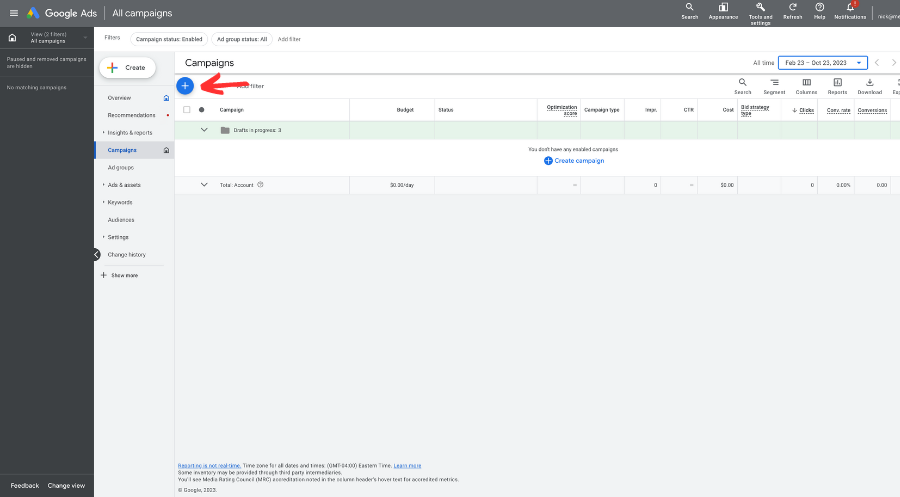
Click on the “Campaigns” tab in your Google Ads dashboard to access the campaign creation process.
3. Choose Your Campaign Type
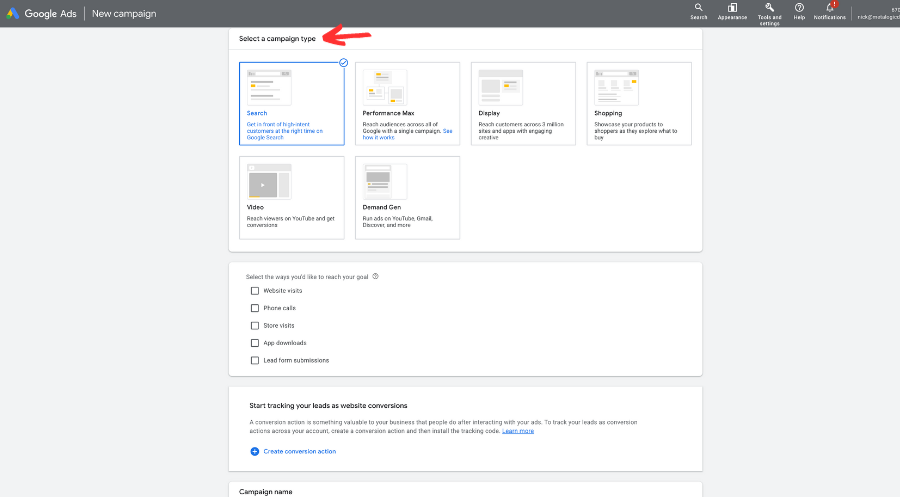
Select one of the Google Ads Campaign types that aligns with your advertising goals. Options include Search Campaigns, Display Campaigns, Video Campaigns, Shopping Campaigns, and more (for this example we will be creating a Search campaign).
4. Name Your Campaign

5. Bidding
Under ‘What do you want to focus on?’, select a bidding strategy that relates to your new campaigns goals.
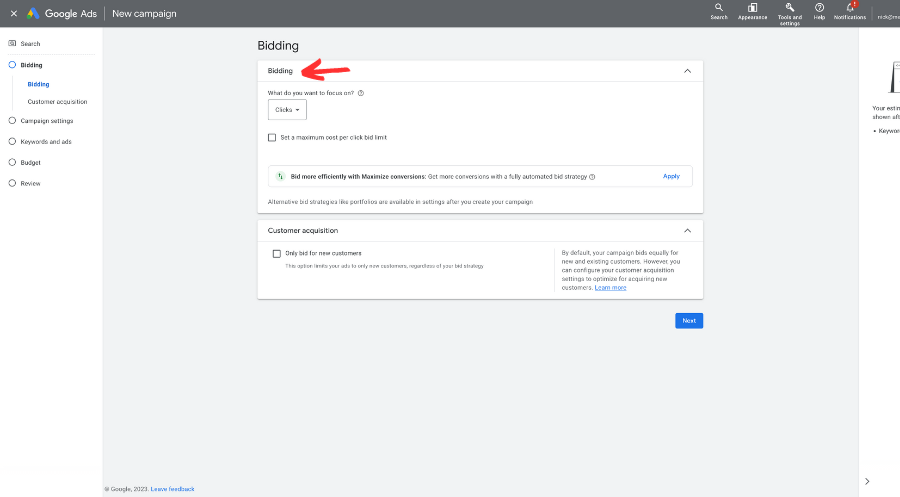
New to Google is the ‘Customer Opposition’ option. This new option limits your ads to only new customers, regardless of your bid strategy but only works under two conditions.
- The advertiser creates an audience segment with at least 1,000 active members in one network (read how to do that here).
- You are running a Performance Max or Search campaign.
Note: We recommend starting your campaign with a Manual CPC bidding strategy. To enable this bidding strategy, go to your campaign settings > Bidding > Change bid strategy > Or, select a bid strategy directly (not recommended) > Manual CPC
6. Campaign Settings
In Campaign settings, you can select the networks, locations, languages, and audience settings for your campaigns.
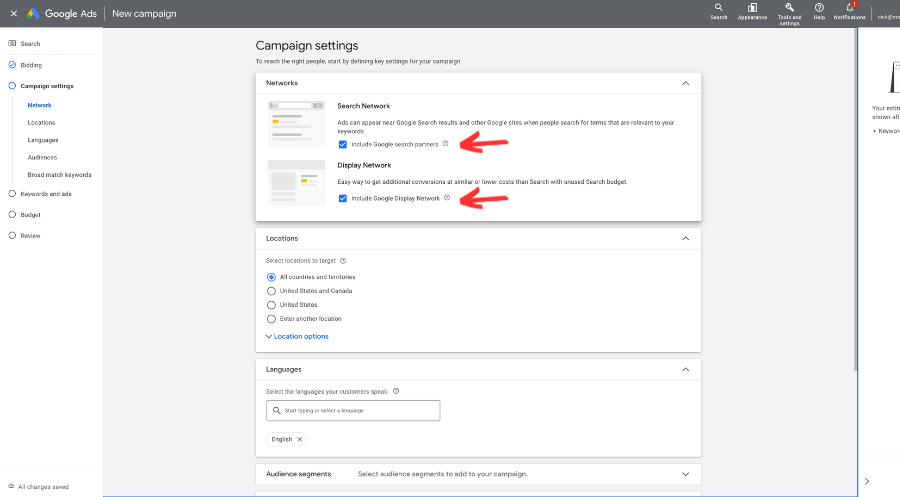
Note: Based on our experience, we recommend unchecking both boxes under ‘Search Network’ and ‘Display Network’ as they generally don’t generate high quality leads while eating through your budget.
7. Keywords and Ads
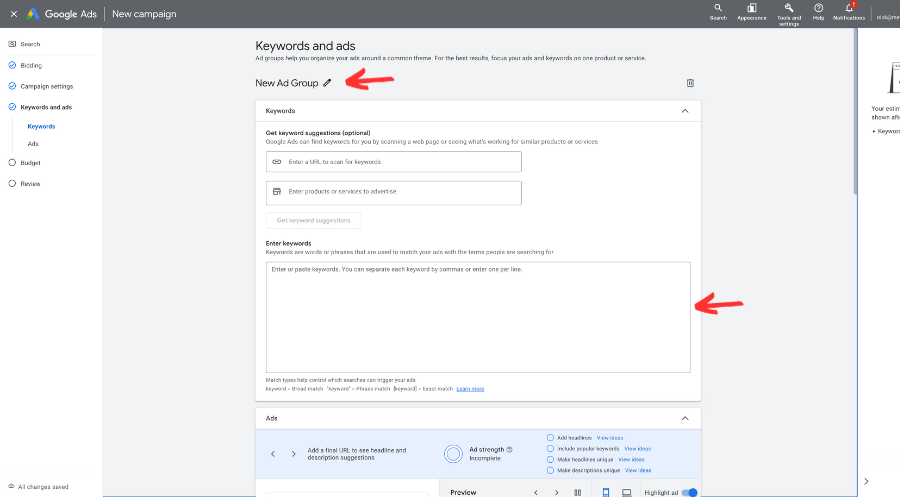
Under ‘Keywords and ads’, name your Ad group and enter the high intent keywords found during your keyword research that you will focus on targeting.
8. Configuring Your Ad
Once you have selected the keywords that you will be targeting, it’s now time to create the ad that potential customers will see when looking for your products or services.
Enter the URL where your Google Ads traffic will be directed to when they click on the ad and configure the display path.
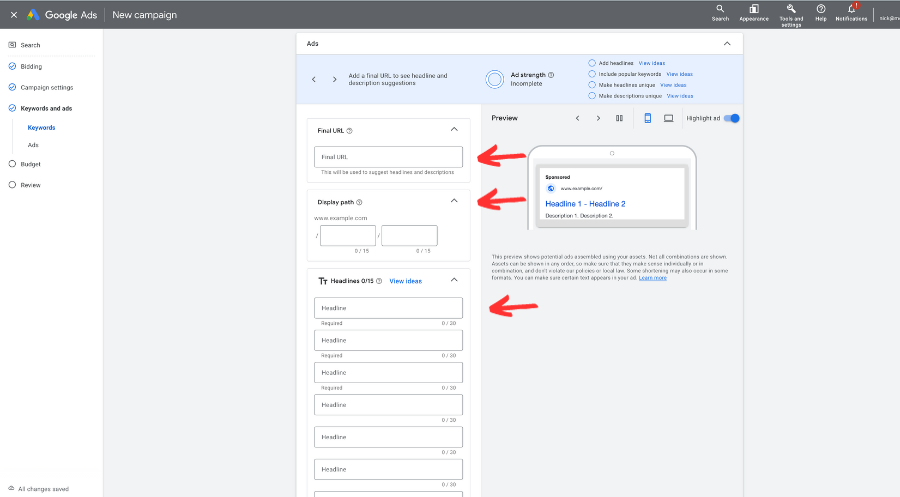
Note: The display path does not actually change the actual URL you’ve chosen to send your ad traffic to. It is merely for show so be sure to add keywords that relate to your product or service to generate more interest from potential clients.
Next, it’s time to create your headlines, arguably the most important aspect of this whole process. In Google Ads, Google automattcally rotated your headlines depending on the keyword Google users that triggered your ad to appear for maximux effectiveness. It is best practice to insert search keyword in your headlines for better ad strength (and indirectly and better quality score.
Ad descriptions allow advertisers to give a brief overview of their product, service, or offerings. Like headlines, your descriptions are also automatically rotated for maximum effectiveness. Be sure to include your search keywords in your descriptions but be aware that you only have 90 characters to play around with.
9. Assets (Ad Extensions)
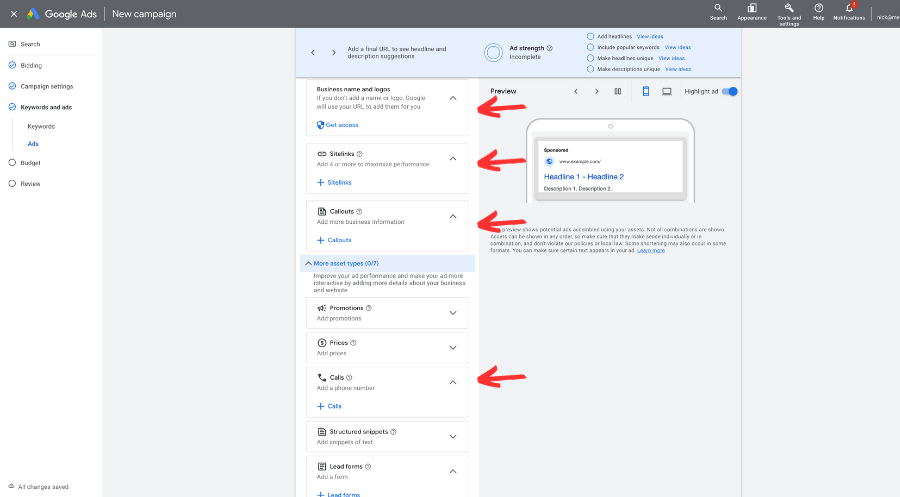
Ad extensions are additional pieces of information that you can include in your Google Ads to make them more informative and appealing to users. These extensions expand your ad and provide extra context, which can increase click-through rates (CTR) and improve the overall performance of your ad campaign. Google offers several types of ad extensions, each serving a specific purpose. Learn all about Google Ads assets here.
10. Budget & Review
Once you have finished setting up your ad, Google will ask you to set a daily budget for your campaign. To do this correctly, divide your monthly budget by 30.4 and input that number as your daily budget. After this is complete, review your campaign settings and click ‘Save’.
Honestly, I consider him part of my Team as well, he really cares about our success. As we grow, he will grow with us. I’m excited about the journey and future with Mike and his Team at Metalogic! If you’re looking at Internet Marketing for your business, simply put he’s the best!

Chris Chustz
Owner, Family First Mortgage
Next Steps After Learning How To Write Google Ad Copy
What’s next after learning how to write Google Ad copy? Creating a perfect Google Ad doesn’t end with the initial setup. To achieve long-term success, you must embrace ad testing and continuous optimization. This ongoing process allows you to refine your campaigns and uncover what works best for your target audience. Here are some things to keep in mind once you’ve created and launched your ad campaign:
A/B Testing
A/B testing, also known as split testing, involves running two or more ad variations simultaneously to determine which one performs better. Google Ads experiments allow advertisers to test different headlines, ad copy, CTAs, and even ad extensions. Monitor the performance metrics (CTR, conversion rate, etc.) to identify the winning ad.
Keyword Performance
Regularly review the performance of your keywords. Identify high-performing keywords that drive conversions and low-performing ones that may need adjustment or removal. As you culminate keyword data, continue to use negative keywords to filter out irrelevant traffic and improve the quality of clicks.
Ad Schedule Optimization
Google Ads schedule optimization is crucial to ensure that your ads appear at the right times. Analyze your ad schedule data to pinpoint when your ads perform best. By adjusting your bidding or scheduling settings accordingly, you can maximize your ad’s impact. Keep time zone differences and the habits of your target audience in mind.
Location Targeting
Location targeting is an area that requires constant monitoring and adjustment. Examine geographic performance data to identify regions that yield the best results for your business. Allocate more budget to high-performing locations while considering excluding underperforming ones. Make the most of geo-targeting options to customize your ads for specific regions.
Device Targeting
Assess how your ads perform on different devices such as desktop, mobile, and tablet. Adjust bids and ad copy to optimize for the devices that generate the most conversions. Ensure that your landing pages are mobile-friendly to accommodate mobile traffic effectively.
Ad Rotation Settings
Ad rotation settings impact how Google Ads distributes your ads within a campaign. Experiment with ad rotation settings to optimize for clicks or conversions. Consider letting Google Ads automatically favor the best-performing ads over time. Remember to regularly refresh ad creatives to prevent ad fatigue and maintain user interest.
Quality Score Optimization
Google Ads quality score improvement is an ongoing effort. Ensure that your ads remain highly relevant to the keywords and landing pages they target. Aim for higher click-through rates (CTR) by optimizing ad relevance and landing pages. A high-quality score can positively impact your ad ranking and cost-effectiveness.
Budget Allocation
Effective budget allocation is essential to maximize your return on investment. Adjust your budget allocation based on the performance of individual campaigns and ad groups. Allocate more budget to top performers while reallocating or pausing low-performing ones.
Competitor Analysis
Competitor analysis is an insightful practice. Keep a close watch on your competitors’ ads and strategies. Identify opportunities to differentiate your ads and capture market share. Stay updated on industry trends and changes in your competitive landscape to remain competitive.
Ad Copy Refresh
Even well-performing ad copy can become stale over time. Learn how to write Google Ad copy regularly update and refresh your ad creatives to maintain user interest and relevancy. Leverage seasonal trends and promotions in your ad copy to capture seasonal demand effectively.
Custom Marketing Plans Starting at $500 / month
Conclusion
From keyword research to compelling ad copy, ad extensions, and the art of testing and optimization, each aspect plays a crucial role in your advertising success. Learning how to write Google Ad copy can be a powerful tool to connect with your target audience, boost brand visibility, and drive conversions. But remember, it’s not a set-it-and-forget-it endeavor; it’s an ongoing journey of refinement and adaptation.
Success in Google Ads often requires patience, persistence, and a commitment to staying ahead of the curve. As you embark on your journey to Google Ads excellence, always remember the words of American entrepreneur and inventor, Thomas Edison: “I have not failed. I’ve just found 10,000 ways that won’t work.” Each iteration brings you closer to the perfect Google Ad that will drive your business to new heights.
Become A Google Ads Specialist With MetaLOGIC's Local Digital Marketing Academy
Want to learn more than how to write Google Ad copy? From display and search campaigns to Shopping and video campaigns, there’s a way to reach your target audience on the Google Ads platform. Don’t wait to see results – Learn more about our Google Ads Online Training Course.








